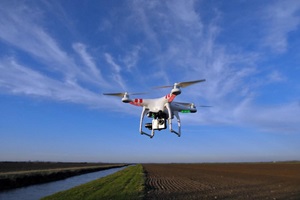- Lidar
- Utility Transformations
- Utility Transformations
- Drones
- Grid Transmission and Distribution
Are Drones About to Catch More Air Among Utilities?

Drones are on the verge of becoming a more commonly used tool by US utilities to improve operations and management of dispersed assets. The latest catalyst is the Federal Aviation Administration’s (FAA’s) new rule called Part 107, which went into effect on Aug. 29. Part 107 comes with some hurdles utility stakeholders need to be aware of, but there is a process that should prove helpful.
Essentially, Part 107 sets the rules for routine commercial use of drones, or small unmanned aircraft systems (sUAS), in the federal parlance. The aim of the rules is to open “pathways towards fully integrating” drones into the nation’s airspace, according to an FAA release. These rules apply to non-hobbyist drone operators who are flying drones weighing less than 55 pounds. The person flying such a commercial drone must be at least 16 years old and hold a remote pilot certificate with a rating for this type of drone, or be directly supervised by someone with such a certificate. A Transportation Safety Administration (TSA) security background check is also required of all commercial drone pilots before a certificate can be issued.
However, there are restrictions likely to frustrate utilities or third-party drone vendors who might contract with a utility to provide drone services. For example, a drone operator must maintain a visual line-of-sight with the drone; keep the drone below 400 feet; fly during the day; keep the drone’s speed below 100 mph; not fly over people; and not fly from a moving vehicle. The line-of-sight and daytime-only restrictions are likely the most onerous to utilities. However, there is a waiver process by which specific restrictions can be removed. That waiver process is supposed to be done within 90 days, but one could expect a backlog, particularly through the rest of 2016 and into next year, assuming there is a flood of waiver filings.
The rules make sense from a cautious regulatory standpoint, but have taken several years to emerge. The slow pace has the US commercial drone market among the laggards compared to other countries, and the US rules are seen as among the most stringent in the world. Nonetheless, the regulatory framework is taking shape, and utilities can make plans.
Beyond Cameras – Lidar
One of the obvious benefits of drones is the use of onboard cameras to inspect grid assets for damage and current condition assessments. But there is another non-camera advantage through the use of lidar technology, which employs laser light instead of radio waves to generate precise, 3D data that can create real-time virtual maps of areas—something quite useful for utilities and transmission and distribution operations. The expectation is that the use of lidar combined with thermal and visual data will pave the way for virtual reality (VR) applications. For instance, a transmission operator could remotely explore storm damage at sites or transmission circuit failures.
The upshot of this new rule is that drones are likely to go from experimental gadgets to important devices in the utility toolbox in the near term. The cost to send drones into the field to monitor remote transmission lines or substations is much less than sending a truck in numerous instances, and as with other new technology, there are likely some new applications not yet devised. For more details of how the drone market among utility stakeholders is likely to unfold, see Guidehouse Insights’ report, Drones and Robotics for Utility Transmission and Distribution. It’s worth a test flight.